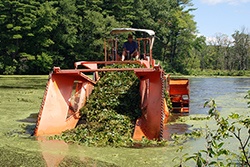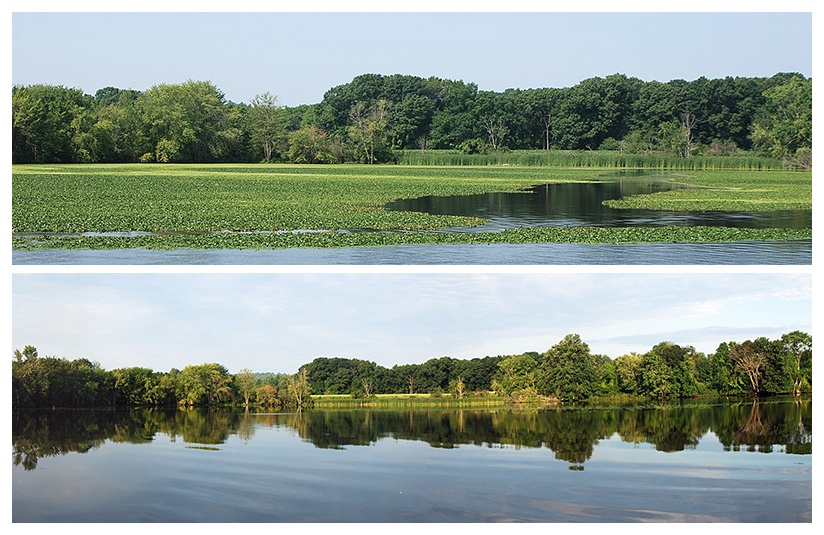Mechanical Harvesting: Effective Nuisance Aquatic Plant Control
April 19th, 2016
Written by Industry Expert, Jeff Castellani, Director of Mechanical Operations
 Mechanical aquatic weed harvesting — there’s no complicated dose calculations, no water use restrictions, and no sophisticated scientific theories, just a technique so direct and effective that even your grandfather would approve of it. This proven and time tested management principle should be the very foundation of aquatic plant management in areas where treatment is not desired.
Mechanical aquatic weed harvesting — there’s no complicated dose calculations, no water use restrictions, and no sophisticated scientific theories, just a technique so direct and effective that even your grandfather would approve of it. This proven and time tested management principle should be the very foundation of aquatic plant management in areas where treatment is not desired.
Mechanical aquatic weed removal services have been employed in the US for over a hundred years, resulting in almost every conceivable type of equipment engineered for a specific purpose. However, the one design that has survived the near continual evolution of this strategy has been that of the aquatic weed harvester. In fact, aquatic weed harvesting equipment has remained virtually unchanged for more than 50 years. These machines consist of a paddle wheel propelled barge equipped with an adjustable sickle-bar cutting head and mesh conveyor system. This simple yet effective design allows these machines to efficiently collect the cut target aquatic vegetation, and access shallow water areas where problematic plant growth often occurs. These machines are produced in various sizes, offering an array of different cutting widths and on-board storage capacities.
Although not always correctly applied throughout the years, mechanical harvesting can be a very effective aquatic plant control technique when used in the right situation. Most frequently, harvesting is employed in the management of annual seed propagating species like water chestnut (Trapa natans). Harvesting these types of plants prior to the development of viable seeds can prevent target plant reproduction, eventually results in long-term control of the unwanted plant infestation. In addition to the control of seed propagating plants, harvesting can be used to provide immediate and area specific relief of nuisance plant growth and can often be used in waterbodies where conditions preclude the use of aquatic herbicides.
 Not only does mechanical harvesting represent an alternative non-chemical management technique, but it is also a very useful component of a larger integrated aquatic plant management program. The ancillary benefit of plant biomass removal can be used to slow the accumulation of organic sediments derived from the annual decomposition of plant material. Additionally, removing dense aquatic vegetation purges the nutrients from the lake system, which is an essential component of any long-term restoration plan. Area selective harvesting can lastly be employed to manage habitat structure for fisheries or other wildlife without significantly altering the vegetative assemblage.
Not only does mechanical harvesting represent an alternative non-chemical management technique, but it is also a very useful component of a larger integrated aquatic plant management program. The ancillary benefit of plant biomass removal can be used to slow the accumulation of organic sediments derived from the annual decomposition of plant material. Additionally, removing dense aquatic vegetation purges the nutrients from the lake system, which is an essential component of any long-term restoration plan. Area selective harvesting can lastly be employed to manage habitat structure for fisheries or other wildlife without significantly altering the vegetative assemblage.
SOLitude Lake Management has long supported mechanical harvesting and, in fact, owns and operates one of the largest fleets of contract harvesting equipment in the country. SOLitude has both large (H10-800) and small machines (H5-130) to address an array of projects, ranging from a 100 acre removal effort of water chestnut in Lake Champlain in Benson, Vermont, to a three acre removal effort of water lily (Nymphaea spp.) for a private landowner. We have seen similar success in controlling retention ponds in order to maintain their function and water storage capacity. SOLitude is currently managing a large water chestnut infestation in six retention ponds and two channels for a large mall in Connecticut. Through the continual mechanical management of these areas, the ponds will be appeased of nuisance plant growth and the associated organic matter buildup in the ponds’ sediment layer.
Often times, the success of both large and small mechanical harvesting projects is dependent upon accessibility and efficiency of the shore-based disposal operation. Depending on the target plant species and the density of the target growth, these types of projects can sometimes yield in the range of 8-15 tons of wet vegetation biomass per acre. Given these high plant volumes, it is critically important to identify suitable shoreline off-loading site(s) as close as possible to the designated work area and have appropriate equipment available to keep the operation moving. In order to facilitate efficient plant disposal, SOLitude has invested in a variety of specialty equipment, such as high-speed transport barges and shore-based conveyor systems.
Mechanical harvesting offers a variety of underutilized benefits for lakes and ponds with invasive aquatic plant growth or systems with just a simple overabundance of native species. The removal of plant biomass and associated nutrients not only provides immediate relief of problematic aquatic plants, but also addresses one of the underlying causes of unbalanced plant production. We encourage you to contact SOLitude’s Mechanical Operations team to see how lake weed removal services can help to improve the condition of your waterbody.
Contact the experts at 888-480-5253 for all of your lake, pond and fisheries management needs.
Jeff Castellani is the Director of Mechanical Operations with SOLitude Lake Management. SOLitude Lake Management is committed to providing full service lake and pond management services that improve water quality, preserve natural resources, and reduce our environmental footprint. Lake, pond and fisheries management services, consulting, and aquatic products are available nationwide. Learn more about SOLitude Lake Management and purchase products at www.solitudelakemanagement.com.










